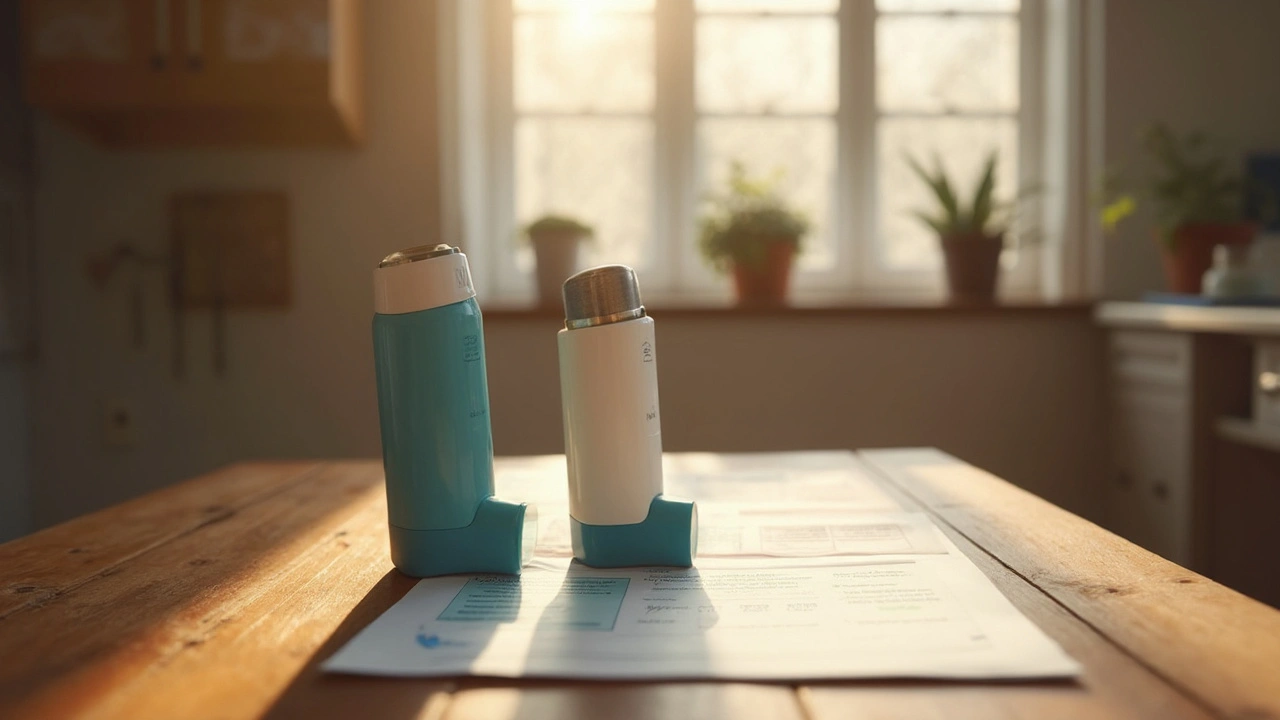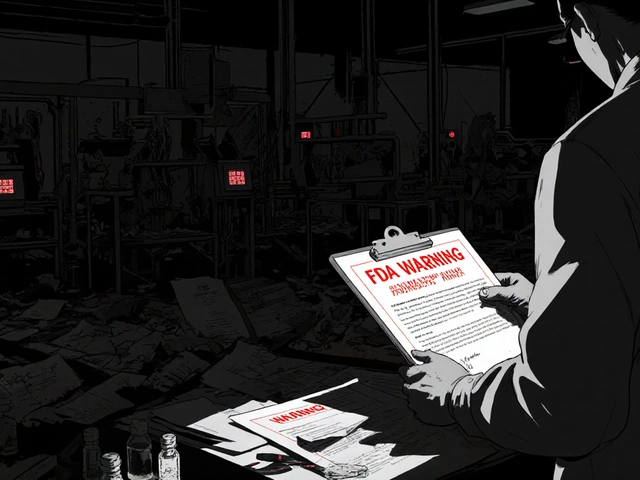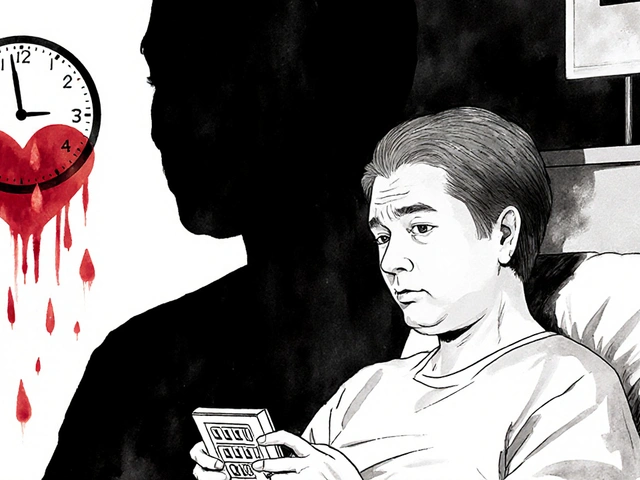
What’s Inside Breztri and Symbicort? Comparing Ingredients & How They Work
The difference between Breztri and Symbicort starts right on the label: these inhalers pack different medicines, and that really changes how they target COPD (Chronic Obstructive Pulmonary Disease). If you crack open the ingredients list, Breztri Aerosphere stands out because it pulls together three medications—budesonide, glycopyrrolate, and formoterol fumarate. That makes it a so-called triple therapy. Meanwhile, Symbicort sticks with a duo: budesonide and formoterol fumarate. Both hit inflammation and help relax tight airways, but Breztri adds glycopyrrolate, known for targeting bronchospasm—the stubborn tightening of airway muscles that makes it hard to breathe in severe COPD cases.
Feeling short of breath even after a rescue inhaler? That’s often where Breztri comes in. The lucky thing about modern inhalers like these is that they’re designed to target symptoms from several directions. Budesonide, found in both inhalers, is an inhaled corticosteroid—it calms down inflamed airways. Formoterol fumarate, also in both, is a long-acting beta2-agonist. Think of it as an agent that keeps airways open for hours, which can help prevent those 2 a.m. wheezing fits. The bonus in Breztri is glycopyrrolate, a long-acting muscarinic antagonist. It's there to keep the muscles around your airways from clamping down, and it works for almost a full day after a dose.
One interesting fact: the combination in Breztri is approved specifically for COPD, not asthma. Physicians like me often hesitate to swap in triple therapy unless someone’s really struggling—maybe you’ve been hospitalized for flare-ups, or you’re relying on short-acting bronchodilators too often. In contrast, Symbicort is FDA-approved for both COPD and asthma (a bonus if you’re juggling both problems). Symbicort is also sometimes used off-label in a single inhaler maintenance and reliever therapy (SMART) plan, especially for asthma—though not for COPD. It's a weird twist in the respiratory world: the same device, but the application is very different depending on your diagnosis.
Don’t ignore the delivery system, either. Both Breztri and Symbicort use pressurized metered-dose inhalers, but Breztri employs the unique "Aerosphere" technology from AstraZeneca. The science-y bit: this system uses a different propellant mix, which helps deliver tiny particles deep into your lungs even if your inhale isn’t super strong (pretty handy if you’re breathless or low on energy some days).
Now, how about side effects? Every inhaler has them, but the extra medicine in Breztri does bring a bit higher risk for dry mouth, urinary retention, and eye issues like blurred vision or narrow-angle glaucoma. Symbicort generally carries slightly less risk here but shares the big ones: thrush (oral candidiasis), hoarse voice, coughing after use, and possible increases in blood pressure or heart rate. The corticosteroid in both can weaken your immune system slightly, so it’s always a good idea to rinse your mouth after a puff. Fun fact: I trained myself with the same inhaler Loki once stole off my desk—do not try to retrieve a medication device from a motivated Siberian cat.
If you ever miss a dose, don’t double up—just take your next puff as usual. Both medications are designed for regular daily use, not as emergency relief. Symbicort sometimes gets used as a reliever for asthma, but that’s not its intended use for COPD management. For either inhaler, stick to your schedule—and if you’re struggling to remember, set reminders on your phone or use a pillbox for inhalers. Yep, they exist now.
Bottom line: when it comes to the actual stuff inside the inhaler, Breztri takes the advantage for controlling severe or frequent COPD exacerbations, while Symbicort is a solid—and sometimes simpler—option for moderate disease. Your doctor might suggest a switch if they see too many urgent care visits on your chart or if you have side effects from one component. Always bring up odd new symptoms, as inhaler tweaks can make a real difference in your day-to-day breathing.

Dosing Differences: How, When, and How Much to Inhale
This is where things get tactical. How you use your inhaler can change how well it works and even how many side effects you face. For Symbicort, it’s easy to remember—the standard COPD dosing is two puffs (160/4.5 mcg per actuation) twice daily, morning and evening. People with asthma might use a lower dose, but the twice-daily ritual remains. The inhaler delivers a consistent dose every time; you get about 120 puffs in a canister, so it lasts one month if you don’t miss a beat.
Breztri is a different beast. Its dosing is two inhalations twice daily, but every actuation delivers three medicines: 160 mcg budesonide, 9 mcg glycopyrrolate, and 4.8 mcg formoterol. Again, that's about 120 inhalations per canister—just four weeks of dosing for most people. Unlike Symbicort, Breztri isn’t meant for asthma at all, so double-check your diagnosis before reaching for the gold-and-brown inhaler.
Let’s talk mistake-proofing: Missing that twice-daily habit is easier than you think, especially if you travel or keep your inhaler at work. Mark your canister or set an alarm if your routine isn’t locked in yet. Some newer canisters even click or display a counter so you always know how many puffs are left. Pro tip: write the "open date" on your inhaler—expired devices drop in effectiveness, but most are good for 90 days after the seal breaks, as long as the cap is on and the device is dry.
Here’s where the real-world gets complicated. Some folks end up using both a maintenance inhaler and a rescue inhaler; others even combine Symbicort with an as-needed albuterol spray. Do not mix and match without a specific plan from your doctor—triple therapy can bump up side effect risks, and using too many bronchodilators back-to-back can cause tremors, palpitations, or potassium dips (true story, I’ve seen it happen during a "habit stacking" hack gone wrong).
If you’re someone who dreads device complexity, Symbicort may feel more familiar—its click-to-dose system is pretty common, and it’s even available in a Turbuhaler dry powder format (mainly outside the U.S.). Breztri’s Aerosphere is a little lighter (handy if your grip is weak on flare-up days), and it’s got clearer dose counters—no more guesswork when you’re close to the end of your inhaler supply.
If you ever get confused by inhaler technique (are you shaking it? Breathing out before inhaling? Holding your breath after your puff?), don’t sweat it. Even my mom, a lifelong nurse, managed to set off her inhaler backwards once. YouTube tutorials can help, but most pharmacies offer a quick demo if you buy in person. Check your form every few months; a little technique boost can mean way better drug delivery, and sometimes breathing more easily is the result of a one-minute retraining, not a new prescription.
The best schedule is the one you can actually stick to. If two puffs twice a day feels unmanageable, talk with your care team—sometimes, simplifying your routine or adding a smart inhaler cap can make all the difference. Don’t try to "save" doses by skipping puffs; you want those medicines in your lungs regularly, not just when you’re wheezing or coughing. COPD is a chronic condition, but smart medication routines help make it predictable, not scary.

Costs, Insurance, and When to Seek COPD Inhaler Alternatives
This is the question that keeps showing up at my local coffee shop, church dinners, and even during walks with my Golden Retriever Max: “Why does my inhaler cost so much?” Prices are a moving target, but as of 2025, both Breztri and Symbicort are among the pricier inhalers if you're paying out-of-pocket. On a regular U.S. retail cash price, expect Breztri to land somewhere between $480 and $580 per canister, depending on pharmacy and location. Symbicort isn't much better—most pharmacies ask around $350 to $450 for a single canister, though discounts, manufacturer coupons, and insurance can radically change your final bill.
If you rely on Medicare Part D, you’ll probably see Breztri and Symbicort hanging out in similar copay tiers—but always check which is preferred by your plan: one might be covered with a much smaller copay, while the other gets slapped with a “non-preferred” penalty. Commercial insurance is even more variable, and some big plans have switched to preferring generic budesonide-formoterol (the generic Symbicort) since 2023. That can save you real money with just a small drop in convenience, if you’re open to changing brands.
Breztri doesn’t have a generic yet, so the drug company’s savings cards and co-pay assistance programs are often your first stop if you’re running into cost barriers. Symbicort, since the generic hit in 2022, is a little easier to get at a lower out-of-pocket cost—especially if you don’t qualify for patient assistance, or if you’re in the “donut hole” of Medicare drug coverage.
Price is just the beginning, though. If you’re traveling or living abroad for part of the year, both inhalers are widely available in Canada and Europe, but with different packaging and sometimes lower costs. If you’re open to mail-order pharmacies or considering a switch, double-check whether international generics are legal in your area—and always buy from licensed sources. Never buy inhalers from flea markets or unverified online sellers; fake medication can be dangerous.
Here’s a practical table comparing current 2025 U.S. average monthly costs for the two:
| Inhaler | Typical U.S. Price/Month | Generic Available? | Insurance Covered? |
|---|---|---|---|
| Breztri Aerosphere | $480-$580 | No | Varies, often with copay card |
| Symbicort (Brand) | $350-$450 | Yes (since 2022) | Frequently |
| Budesonide/Formoterol (Generic Symbicort) | $200-$300 | Yes | Often preferred |
Can’t afford either? Talk frankly with your doctor or pharmacist. Sometimes, a combination of two separate inhalers (one LABA, one ICS) can produce the same therapeutic effect for less money, even if it means juggling two devices instead of one. If you want more detail or ideas for covering gaps in therapy, I’ve found this resource on Breztri alternatives really helpful—it’s got up-to-date info on what’s new, and which inhalers are rising in popularity for those trying to find the right fit (or a better deal).
If out-of-pocket cost pushes you to switch, don’t do it solo. Talk to your medical team and spell out why you’re considering the change. They might have manufacturer samples, access to local discount programs, or updated scripts for generics. Never let cost force you off life-saving therapy—there’s always another path to try.
Final tip: track your refills with a calendar. If you’re using more puffs than prescribed, or getting out of breath before your next dose, that’s a classic sign something isn’t working right. It might be technique, the medicine choice, or even a sudden worsening in your lung function. Touch base with your care team, jot down questions, and come prepared. With COPD, you should never settle—your best days are still ahead, and picking the right inhaler can make all the difference.







20 Comments
my cat loki is now officially the most expensive respiratory therapist in canada.
also breztri? looks like a space weapon.
but hey, if it stops me from sounding like a dying kazoo at 3am, i’ll take the extra $500.
they don’t want you to get better, they want you to stay dependent.
why not just give us oxygen tanks and call it a day?
oh right, because there’s no patent on air.
and don’t get me started on the "aerosphere" nonsense-sounds like a sci-fi movie prop.
you know what’s really in there? corporate greed and a 20-year-old chemist who got paid in stock options.
and yes, i’ve read the FDA documents. all 4,000 pages.
they didn’t test it on actual humans, just lab rats with tiny lungs.
you think your inhaler helps? it’s just delaying the inevitable.
we’re all just breathing in corporate lies.
we’re treating symptoms while ignoring the air we breathe, the food we eat, the stress we carry.
why are we okay with this?
why do we accept that our lungs are just broken machines that need more chemicals to keep ticking?
the real question isn’t breztri vs symbicort-it’s why we let corporations decide what "health" means.
you think this is about science?
it’s about profit margins and shareholder meetings.
and yet we still call it progress.
we’re not curing COPD-we’re monetizing it.
and the saddest part? we’re grateful for the crumbs.
they just repackaged it and sold it to asthmatics.
the same company that makes your inhaler also makes the nerve agent dispersal tech used in syria.
they’re the same patents. same engineers. same ethics.
and you’re still using it?
you’re literally inhaling war technology.
your "maintenance dose" is a silent bioweapon.
and the government? they approved it.
they always do.
wake up.
we breathe through pain and still laugh.
your problem isnt your lungs, its your wallet.
why u pay so much for plastic tube?
we use old socks and boiling water. works better than your "aerosphere".
u need to go back to africa. learn real medicine.
no one takes these things right.
shake it? no. breathe out? no. hold it? no.
you’re just puffing air and hoping for magic.
the science is solid.
the user is broken.
fix yourself before blaming the device.
my dog even noticed. he used to whine when i was wheezing. now he just stares at me like "who are you and what did you do with my human?"
also i write the date on the canister like the post said.
it’s tiny but it helps.
thank you for the tip.
no more 4am panic attacks.
no more calling my sister crying because i couldn’t get air.
it’s expensive? yes.
but so is a hospital bill.
and i’d rather pay $500 than lose my independence.
if you’re debating this, you’re already losing.
your maintenance inhaler is your shield.
not your weapon.
use it like your life depends on it.
because it does.
and yes breztri costs more but you’re not paying for the inhaler.
you’re paying for peace of mind.
and that’s priceless.
it felt like a reminder i was broken.
but now? i see it as a tool.
a quiet ally.
it doesn’t define me.
it just helps me be me.
and honestly?
that’s enough.
she’s been stable for 2 years.
she doesn’t need triple therapy.
she needs consistency, not complexity.
if your doctor didn’t explain why they switched you, ask again.
sometimes simpler is smarter.
and cheaper.
and honestly?
it works.
1. Shake well (5 seconds minimum).
2. Breathe out fully-away from the inhaler.
3. Press and inhale slowly over 3-5 seconds.
4. Hold breath for 10 seconds.
5. Rinse mouth with water.
6. Wait 30 seconds before second puff.
7. Write date on canister.
8. Keep it dry.
9. Don’t trust the counter if it’s cracked.
10. If you’re still unsure? Ask your pharmacist.
they’ve seen it all.
and they won’t judge you.
it’s not just a "mix."
it’s engineered for low-impedance deposition in the lower lobes.
the particle size distribution is optimized for 1.5-3.5 microns.
that’s why it works even with weak inhalation.
you’re not imagining the difference.
it’s physics.
and yes, it’s expensive because R&D isn’t free.
stop being lazy and start reading the damn pamphlet.
they’re testing it on us.
you think that’s a coincidence?
same company makes the vaccines.
same company makes the inhalers.
same people in the same boardroom.
they want you to be dependent.
they want you to need more.
they want you to forget you’re breathing.
and then?
they’ll sell you the cure.
in 2030.
probably for $1,000.
and you’ll pay it.
🥺
we have church ladies with nebulizers in the back of their minivans.
we have people trading pills like baseball cards.
we have grandparents who use expired inhalers because they can’t afford new ones.
and you know what?
they still show up.
they still laugh.
they still breathe.
so don’t you dare tell me this is just about medicine.
this is about who gets to live.
and who gets to pay.
generic.
effective.
cheaper.
stop overcomplicating your life.
you don’t need triple therapy unless you’re on oxygen 24/7.
and if you are?
you need a new doctor.
my lung function improved by 22% in the first year.
my daughter says i smell like peppermint now.
and i’m okay with that.
it’s better than the smell of panic.
if you’re worried about cost, talk to your pharmacist.
they know every discount, every coupon, every loophole.
and if you’re still struggling?
reach out.
someone out there will help.
you’re not alone.
💙
and that’s enough.
❤️
then i realized it was the only thing that didn’t give up on me.
so now i thank it.
out loud.
every morning.
even if it costs more than my rent.
it’s worth it.
it’s not three drugs.
it’s three mechanisms: anti-inflammatory, bronchodilator, anticholinergic.
that’s the real innovation.
you’re not getting more chemicals.
you’re getting a multi-targeted approach.
and for severe COPD?
that’s the gold standard.
don’t let cost scare you.
talk to your provider.
there’s always a path.